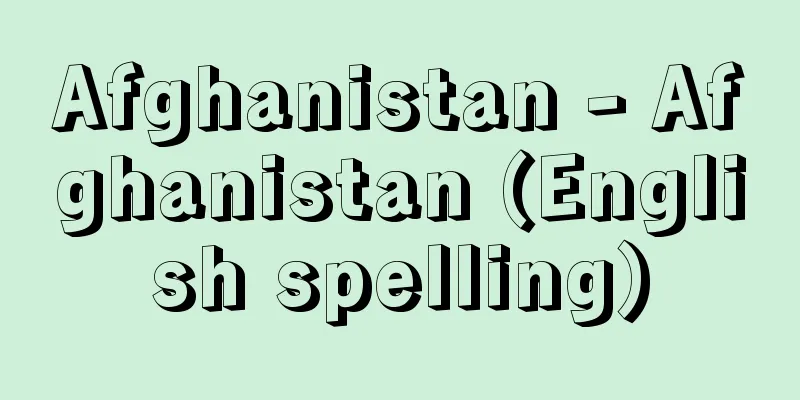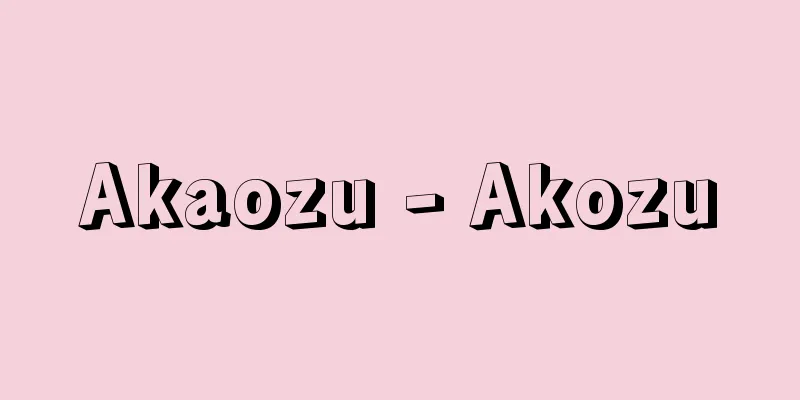Afghanistan - Afghanistan (English spelling)

|
A landlocked country in Southwest Asia, surrounded by Pakistan, Iran, China, Tajikistan, Uzbekistan, and Turkmenistan. Afghanistan means "land of the Afghans". The formation of the nation by the Afghans began in the mid-18th century, and by the end of the 19th century, it had become a nation, and was internationally recognized as an independent country in 1919. In 1973, the monarchy that had existed since the country's founding was overthrown, and it became a republic. In 1978, it became the Democratic Republic of Afghanistan, and in 1987, it became the Republic of Afghanistan. Its official name is the Islamic Republic of Afghanistan. It is a landlocked country centered on the Hindu Kush Mountains, and is a multi-ethnic nation. This region was once a key location, so-called "crossroads of civilizations" that connected the east-west transportation route of the Eurasian continent with India, but it was little influenced by European developments such as advances in science and technology and the Industrial Revolution, and has been left behind by modernization to this day. Area: 652,225 km2, population: 27,145,000 (2007 estimate), capital: Kabul. [Takeshi Katsutō] NatureIts area is 1.7 times that of Japan, and it is located between 29 and 38 degrees north latitude, a little south of the main island of Japan. There are several mountain ranges running from northeast to southwest, collectively known as the Hindu Kush Mountains. They are higher in the northeast and lower in the southwest. The highest peak is Mount Noshakh (7,470 meters). The area north of this mountain range is called Turkestan (Afghan Turkestan), which is a plain several hundred meters above sea level, with a mild climate suitable for agriculture. All major rivers originate in the Hindu Kush Mountains. North of the range, the Oxus River (Amu Darya) originates in the Pamir Plateau, and its upper reaches form the border with Tajikistan and flow into the Aral Sea. The Murghab River also flows north into Turkmenistan. On the south side of the range, the Kabul River flows east into Pakistan and empties into the Indus River. The Helmand River flows southwest and empties into a lake near the border with Iran. The Khali Rud River irrigates the Herat Plain, part of which forms the border with Iran. The climate varies by region, especially by altitude, but generally it is dry, with rain in the summer and dry in the winter. In the capital Kabul (latitude 34°33′N, altitude 1766m), the average maximum temperature is 24.4°C in July, the minimum is -2.8°C in January, and the average humidity is 73% of that in January and 38% of that in June-July. The annual precipitation is about 340mm, 70% of which falls in January-April, and there is almost no rain in July-September. The hottest part of the country is the southwest, where the maximum temperature in summer is always over 40°C, and it is a dry, uninhabited wilderness. In the Herat region, a north wind called the "120-day wind" blows in summer. The southeastern mountainous region is exposed to the Indian Ocean monsoon, which is rainy in summer and dry in winter, with annual precipitation exceeding 500mm, and it grows forests. In the southern city of Kandahar (latitude 31°30′ north, 1010m above sea level), the average maximum temperature is 32.1°C in July, the minimum is 5.5°C in January, the average humidity is 59% of the maximum in February, and 23% of the minimum in June, and the annual precipitation is 198.1mm. There is a proverb that says, "Kabul may not have gold, but it must have snow." This means that it is the snow that accumulates in the mountains to the west that nourishes the residents of Kabul. The snow that falls on the mountains from autumn to winter melts and becomes surface water, or seeps into the groundwater. The residents use this water. Because the temperature is low in the mountains, the snow melts little by little. At the end of summer, when the snow has almost disappeared, new snow falls again, and snow remains in the mountains throughout the year, providing drinking water for humans and livestock and irrigating crops. [Takeshi Katsutō] historyThe name "Afghans" appears in a 10th century Persian geography book as a mountain people living near the border between present-day Afghanistan and Pakistan. A 14th century history book refers to the same region as Afghanistan. The tribe moved eastward and established the Lodi and Sur dynasties in India in the 15th and 16th centuries, centered around Delhi. During the reign of Mughal Emperor Aurangzeb, the Pashto classical poet Khoshar Khan Khattak (1613-1689) appeared. In 1722, the Ghilzai Afghans occupied Isfahan and destroyed the Safavid dynasty. Nadir Shah Afshar, who appeared at the end of the dynasty, drove out the Afghans, invaded India, and temporarily occupied and plundered Delhi. When Nadir returned home and was assassinated in June 1747, Ahmad Shah, a Durrani who had been the head of the Afghan troops under Nadir, returned to his hometown of Kandahar and was promoted to head of a tribal alliance in July. This marked the beginning of the founding of Afghanistan. He expanded his territory through repeated wars of conquest from east to west. His son, Timur Shah, moved the capital from Kandahar to Kabul. In the 19th century, Britain replaced the Mughal Empire as a powerful enemy in the east of Afghanistan. Meanwhile, in the north, Russia expanded its power by overwhelming the Turkestan khanates. Both Britain and Russia exerted influence over Afghanistan. Irritated by the attitude of the Afghan government, which was torn between the two great powers, Britain sent troops from India to Afghanistan twice. This was the Afghan War. However, both times Britain only suffered losses and was unable to completely conquer the country. Abdul Rahman (reigned 1880-1901) was an autocratic monarch who attempted to unify the country, and negotiated with Britain to help develop the Afghan state. From Britain's perspective, this was to their advantage as it would make the country a buffer state against Russia. After Afghanistan gained independence in 1919 after Britain handed over diplomatic rights to it, the country's path swung between the extremes of Westernization and nationalism. As a landlocked country, it was inevitable that it would lean toward nationalism. Even after World War II, Afghanistan maintained a non-aligned neutrality amid East-West tensions. However, because it felt a sense of rivalry with its neighbors to the east and west, Pakistan and Iran, which were clearly pro-Western, it inevitably became dependent on its northern neighbor, the Soviet Union. In 1973, Mohammed Dawood, a member of the royal family and former prime minister, staged a coup while King Zahir Shah was abroad, proclaiming a republic and making himself president. The King sent a letter of abdication to Dawood from Italy, where he was staying. In 1978, a coup led by young officers took place, killing President Dawood and leading a left-wing, pro-Soviet regime under Noor Mohammed Taraki. In 1979, with the Soviet army moving in (withdrawing in 1989), Babrak Karmal took full power, but was ousted in 1986. In 1987, Najibullah became president. [Takeshi Katsutō] PoliticsAt the end of the long reign (1933-1973) of Afghanistan's last king, Zahir Shah, in 1970, the political system was as follows. First, there was the Cabinet as the executive branch, and under the Prime Minister were 14 Ministries: Foreign Affairs, Interior Affairs, Defense, Law, Planning, Finance, Commerce, Public Works, Education, Information and Culture, Posts, Health, Mining and Industry, and Agriculture and Irrigation, as well as the Tribal Affairs Bureau, which was equivalent to a ministry. In addition to the ministers of each ministry, there were one or two Deputy Prime Ministers, who either held the position full-time or held the position of ministerial minister, and until 1963, a member of the royal family served as Prime Minister. In terms of local administrative divisions, the country was previously divided into seven major provinces and seven minor provinces, but in 1964 this was reorganized into 29 provinces (wilayats), and currently there are 34 provinces. Under the provinces were districts (Uluswari) or counties (Arakadari). Villages are municipalities. The legislative branch consisted of two houses, the upper house with 28 appointed members and 56 elected members, totaling 84, and the lower house with 215 elected members. In addition to the two houses, there was the Loya Jerga (Grand Assembly), a meeting held in times of national emergency. This was derived from the Afghan custom of a tribal assembly called a Jirga, and its members were the members of both houses and the speakers of the provincial assemblies. The judicial branch consisted of the Supreme Court in the capital, with a chief justice and nine other judges (composed of lay and clerical members). Under it were the Court of Appeals in the three major cities of Kabul, Kandahar, and Mazar-i-Sharif, the district courts in each province, and the primary courts in each district. The 1964 constitution stipulated that Islam was the state religion and that rituals were to be conducted according to the Hanafi school of Sunni Buddhism. It also stipulated that, in accordance with Islamic tradition, coins were to be minted in the king's name and that the king's name was to be recited in Friday sermons in mosques. In April 1988, the Afghanistan Peace Agreement was concluded between the United States (President Reagan), the Soviet Union (General Secretary Gorbachev), Afghanistan (President Najibullah), and Pakistan (Prime Minister Bhutto), and the Soviet troops completed their withdrawal by February 1989. Shortly thereafter, armed groups opposed to the Najibullah government became more active, attacking the capital, and in 1992 Najibullah resigned as president and a coalition government was established with the Tajik national Rabbani as head of state. However, the political situation was far from stable, and civil wars continued. From around 1994, the Taliban (meaning "religious students"), an armed group of seminarians calling for a return to Islam, rapidly expanded their influence, and in September 1996 they took control of Kabul. They killed former President Najibullah, who had been sheltered in a UN facility in the city. The Rabbani government collapsed, and the Taliban took control of almost the entire country. In September 2001, a series of terrorist attacks occurred in the United States, and the US government demanded the handover of Osama bin Laden, the alleged mastermind of the attacks, who was believed to be hiding in Afghanistan. However, the Taliban refused, and the US-UK coalition forces launched an attack on Afghanistan. At the same time, the anti-Taliban Northern Alliance launched a counterattack, seizing control of the capital, Kabul, in November, and the Taliban regime collapsed. In light of these developments, and with the mediation and advice of the United Nations and others, a provisional administrative body was established in December, with Hamid Karzai (1957- ) as its chairman. In June 2002, the country transitioned to a provisional government, and Karzai was elected president. In January 2004, a new constitution was adopted at the Loya Jirga (Great National Assembly). In October, the first presidential election was held, and Karzai was elected. The presidential term is five years. In 2005, elections were held for the lower house of parliament and provincial council members. The National Assembly is bicameral, with 102 seats in the upper house. It is made up of 34 representatives from the provincial and district assemblies, and 34 members appointed by the president, and serves a four-year term. The lower house has 249 seats, 68 of which are reserved for women. The term is five years. Meanwhile, although the Taliban was driven out of power, they continue their armed anti-government struggle. Terrorism has been increasing in various places, including the kidnapping of a Korean in July 2007 and the attempted assassination of the president in April 2008, and it is believed that the Taliban and Al-Qaeda are involved. Furthermore, in August 2008, a Japanese NGO (non-governmental organization) employee was kidnapped and murdered by an armed group. The national army has 50,000 troops in the ground and 1,400 in the air force. The International Security Assistance Force (ISAF), a multinational force, has a total of 51,350 troops from 41 countries (as of the end of 2008). [Takeshi Katsutō] Economy and IndustryThe Afghan economy is supported by the traditional industries of agriculture and livestock farming, and in 2004, 65.6% of the working population was engaged in agriculture. Furthermore, due to the lack of natural resources, it is one of the poorest countries in the world. Currently, the most important natural resource is oil, but unlike neighboring Iran, no oil fields have been discovered in the country despite vigorous exploration. However, natural gas was discovered in Khaja Gogerdak and Yateem Tak in Jawzjan Province, Turkestan, and has been extracted since 1967. Technology and capital were dependent on the Soviet Union, and part of the gas was sent to the Soviet Union as repayment for aid. However, due to the withdrawal of Soviet engineers and the effects of the civil war, development has not progressed since then. Other mineral resources are limited in variety and quantity. Coal is produced from three coal mines in Baghlan Province and Samangan Province. All of them are located north of the Hindu Kush Mountains, and transportation to the capital, Kabul, is difficult. Rock salt is found near Tari Khan, and the semi-precious stone lapis lazuli is produced in Badakhshan province and is crafted in Kabul. Afghanistan's main industry is agriculture. As it is located in an arid zone, artificial irrigation is necessary, and the amount of farmland is regulated by the amount of water required for irrigation. Most irrigation methods involve drawing water from rivers, but there is also a method of bringing groundwater to the surface through artificial underground waterways called "qanat" or "kharez", which are widely seen in Western Asia. A characteristic of land ownership is that most farmers are self-cultivating, and large landholdings are not common. In 1960, 60% of the total cultivated land in Afghanistan was self-managed, compared to 28% in Iran. Since then, it is said that one-third of the cultivated land area has been destroyed due to the deterioration of the domestic situation and the subsequent civil war. According to estimates in 2001, the cultivated land area was 7.91 million hectares, of which 2.39 million hectares were irrigated. In 2005, the agricultural land area (arable land and orchards) was approximately 8.05 million hectares, and the area of pastures and pastures was 30 million hectares. In 2006, the largest agricultural production was wheat at 3.2 million tons, followed by rice at 540,000 tons, corn at 240,000 tons, and potatoes at 240,000 tons. Among fruit crops, almonds and grapes are the most produced. In recent years, a major agricultural problem has been the cultivation of poppies, the source of opium. Poppy production temporarily decreased, but has risen sharply again since 2002, reaching 4,200 tons in 2004. Poppy production is particularly high in the southern region, and there are concerns that it will strengthen the economic base of the Taliban, an armed group. The livestock kept are, in order of number, sheep, goats, cattle, donkeys, camels, and horses. Among the sheep, there is the Karakul sheep, which are killed immediately after birth and their fur is used for coats and hats. In 2005, the livestock numbers were 8.8 million sheep, 7.3 million goats, and 3.7 million cattle. Livestock farming is carried out in two ways: farmers raise a small number of animals for their own consumption, and nomads move to a large scale to raise livestock as a business. Most of the nomads are Afghan. Those who live south of the Hindu Kush have summer camps in the mountains, known as Hazarajat. Some come up here from Pakistan across the border. In Afghan Turkestan, the summer camps are around Lake Siwa in the northeastern corner of the country. In 2007, the gross domestic product (GDP) was $11.63 billion, and the per capita GDP was $319 (2006). Of the total trade, exports were about $900 million, while imports were about $4.1 billion (2005), resulting in a large trade deficit. As the country's main industries are agriculture and livestock farming, the top export items are fresh and dried fruits such as grapes, pomegranates, apples, plums, almonds, raisins, and pistachios, nuts, and agricultural and livestock products such as Karakul sheepskins, cotton, carpets, and wool. The main import items are automobiles and their parts, steel, and chemical fibers. According to statistics from 2006, the top export destinations for Turkey are Pakistan, the United States, Germany, Russia, and India, while the top import destinations are Singapore, Japan, South Korea, China, and India. In the past, the Soviet Union was the top export destination and import destination. There is a large trade surplus with Japan, with exports to Japan amounting to approximately 75 million yen in 2008 (Heisei 20) and imports from Japan amounting to approximately 11,962 million yen. Being a landlocked, mountainous country, it was difficult to develop roads, but with assistance from the United States and the Soviet Union, a trunk road circumnavigating the country has been almost completed. In particular, the tunnel road at Sarang Pass (3,363 meters above sea level, 2,676 meters long), which crosses the Hindu Kush mountain range from north to south, is extremely important for transportation with neighboring countries to the north. [Takeshi Katsutō] Society and CultureThe population composition in 2007 was estimated to be 44% Afghan, 25% Tajik, 10% Hazara, and 8% Uzbek. According to the United Nations High Commissioner for Refugees (UNHCR), approximately 370,000 Afghan refugees returned home from Iran, Pakistan, and other countries in 2007. As of the end of 2007, there were approximately 3.06 million Afghan refugees outside the country, of which approximately 2.03 million were living as refugees in Pakistan. Afghans call themselves "Pashtuns," and are called "Pashtuns" by the Indian side. They are Caucasian, and their native language is Pashto. It belongs to the Indo-Iranian branch of the Indo-European language family, just like Persian, and is written in Arabic characters. The second largest population after the Afghans is the Tajiks, who are also Caucasian and whose native language is Persian. Other large populations include the Mongoloid Uzbeks (Uzbek-speaking Altaic language family) and Hazaras (Persian-speaking). With the exception of a small number of Hindus and Sikhs, 99% of the population is Muslim, of which 86% are Sunni and 9% (mainly Hazaras) are Shiite. Since the country's founding, Afghans have been the dominant ethnic group, followed by Tajiks. Hazaras were a lower class, but after the republic was established some of them began to advance to higher government positions. The constitution stipulates that Pashto and Dari (the official name of Persian in Afghanistan) are the official languages, but in reality Persian is the official and common language. The government has been working to popularize Pashto out of Afghan nationalism, but has not seen results. Many residents are "bilingual," using their mother tongue and Persian, the common language. Clothing is made from cotton and sheep or goat wool. Long-legged shirts and wide trousers are the basic traditional clothing. Western clothing is not yet common. The staple food is wheat bread, supplemented by barley or corn. Rice is a luxury item, eaten only on special occasions. An important secondary food is dairy products, mainly processed cow's milk into yogurt and cheese, which are eaten with bread. Meat comes from sheep. The main beverage is tea, which includes black and green tea. Many people eat with their fingers, without using knives and forks. The main material of the houses is sun-dried bricks. Ordinary earth is mixed with water, put into a frame, and dried in the sun. These are piled up and hardened with mud made from ordinary earth. The roof is either flat with wooden beams, or spherical with bricks piled up in a dome shape. There are no desks, chairs, or beds inside the houses; people sit on mats laid on the floor and sleep on futons. The spread of education is slow, with adult literacy rates of 43% for men and 14% for women (2003). The school system began at the end of the 19th century under the influence of British India, and France and Germany also contributed to the establishment of secondary schools. After World War II, the 6-3-3-4 system was established with assistance from Western countries, mainly the United States. During the monarchy, there were only two universities: Kabul University, which became a comprehensive university in 1946, and Ningurahar Medical University, which was established in 1964. Later, a technical university and other institutions were established, bringing the total to five. Primary education, which forms the base of school education, is gradually becoming more widespread. In remote rural areas, schools with only one class that teaches reading, writing, and arithmetic are run by traveling teachers. As for the basic level of reading and writing, classes taught by monks at Islamic mosques are still functional. The status of women was changing, and in 1959 a clothing revolution occurred. At an event celebrating the Independence Day in August of that year, Prime Minister Dawood and other government officials appeared in public accompanied by their wives, who were barefaced. The custom of covering the whole body with a headgear called a chador began to crumble around this time, but has not yet disappeared completely. However, under the Taliban regime since 1996, education and outdoor work for women were banned, and strict Islamic revivalism (fundamentalism) rule was also implemented in the cultural sphere. In February 2001, the Taliban regime issued the "Buddha Statue Destruction Order" and began destroying Buddha statues at ruins and museums around the country. The great Buddhas and murals of the famous Bamiyan caves were destroyed, with most of them lost. Islam dominates the minds of the Afghan people. It entered the region in the second half of the 7th century, eradicating the Buddhism and Zoroastrianism that existed until then. Islam has taken deep root in the land, and has not lost its authority despite contact with the West. There are mosques in towns and villages, where prayers are performed five times a day, and the fasting of the ninth month of the Islamic calendar is observed quite faithfully. The most important area of culture in the country is classical Persian literature, and works such as Saadi's The Rose Garden are still widely read. The official calendar is the Iranian calendar, a solar calendar that begins on the vernal equinox. While this traditional culture is preserved, journalism is underdeveloped. Literacy is low, resulting in a small readership, and economic conditions are poor, so publishing is not thriving. All publishing is under government supervision. However, during the temporary period of dispute following the departure of the royalist Prime Minister Daoud in 1963 and the "guarantee of freedom of speech" under the 1964 Constitution, private newspapers "Khalq" (April-May 1966) and "Parcham" (March 1968-July 1969) were published. Although both were only published for a short period of time, the activists who gathered in these newspapers formed their own political organizations and had a great influence on the country's politics thereafter. Nur Muhammad Taraki, chairman of the Revolutionary Council at the time of the establishment of the Democratic Republic, was the publisher of "Khalq," and Karmal was a contributor to "Parcham." The People's Democratic Party was a coalition of the two factions. When the Taliban came to power in 1998, the media was restricted and television broadcasting was banned. However, after the collapse of the Taliban regime, television broadcasting was restored and private newspapers are now being published. [Takeshi Katsutō] Relations with JapanAfghanistan, which does not produce oil, has not been of economic interest to Japan. However, it attracts the interest of Japanese travelers because it is the place where the vestiges of the Silk Road remain the best. In the academic field, since it is the route by which Buddhism was introduced from India to Japan, research has been conducted on Buddhist ruins, and research has also been conducted on the Mongolian language that is still preserved by ethnic minorities, and on the actual conditions of Afghan nomads, but since the Soviet occupation, the relationship between the two countries has become somewhat estranged. The Japanese government has not recognized the successive governments of Afghanistan since December 1979 (Showa 54), but in 2001 (Heisei 13), it recognized the Afghan Provisional Government as the government. The embassy was opened as a Japanese legation in 1934 (promoted to an embassy in 1955, and has been at the level of chargé d'affaires ad interim since December 1979). It was closed in 1989, but reopened in 2002. The Afghanistan Embassy in Japan had been closed since 1997, but resumed operations in 2002. Foreign Minister Kawaguchi Yoriko visited Afghanistan in 2002, and President Karzai visited Japan in 2003. Since then, there have been frequent visits by VIPs. The Embassy also provides assistance for reconstruction such as road and rural development, as well as humanitarian and medical assistance to Afghan refugees. Since the September 11 attacks in the United States in September 2001, the total amount of reconstruction assistance provided to Afghanistan as of March 2009 was 1.783 billion dollars. [Takeshi Katsutō] "Modern Middle East History I" by Katsuto Takeshi et al. (1982, Yamakawa Publishing)" ▽ "New Middle East Handbook" edited by Itagaki Yuzo, supervised by Nagai Michio (1992, Kodansha)" ▽ "History of Afghanistan" by Maeda Kosaku and Yamane Satoshi (2002, Kawade Shobo Shinsha)" ▽ "Afghanistan: UN Peace Activities and Regional Conflicts" by Kawabata Kiyotaka (2002, Misuzu Shobo)" ▽ "Prospects for the Reconstruction of the Afghan Nation" edited by Suzuki Hitoshi (2007, Akashi Shoten)" ▽ "Afghanistan and Neighboring Countries" edited by Suzuki Hitoshi (2008, Institute of Developing Economies)" ▽ "Afghanistan: A Modern History of War" by Watanabe Koichi (Iwanami Shinsho) [References] | | | | | | |Karma| | |Suri | | | | | | | | | | | [Additional resources] |"> Afghanistan flag ©Shogakukan Illustration/Shogakukan Creative "> Afghanistan location map Source: Shogakukan Encyclopedia Nipponica About Encyclopedia Nipponica Information | Legend |
|
パキスタン、イラン、中国、タジキスタン、ウズベキスタン、トルクメニスタンに囲まれた西南アジアの内陸国。アフガニスタンとは「アフガン人の地」という意味で、18世紀中ごろにアフガン人による国家形成が始まり、19世紀末に国家の体裁をほぼ整え、1919年に独立国として国際的に承認された。1973年、建国以来の王制が倒れ、共和制となる。1978年アフガニスタン民主共和国、1987年アフガニスタン共和国となる。正称はアフガニスタン・イスラム共和国Islamic Republic of Afghanistan。領域はヒンドゥー・クシ山脈を中心とした内陸国で、多民族国家である。この地域はかつてはユーラシア大陸の東西交通路とインドを結ぶいわゆる「文明の十字路」にあたる要地であったが、科学、技術の進歩や産業革命などヨーロッパの発展の影響を受けることが少なく、近代化から取り残されて現在に至っている。面積65万2225平方キロメートル、人口2714万5000(2007推定)。首都カブール。 [勝藤 猛] 自然面積は日本の1.7倍、北緯29度から38度までで、日本の本州より少し南にあたる。北東から南西にかけていくつもの山脈が走っており、ヒンドゥー・クシ山脈と総称される。北東に高く、南西に向かって低くなる。最高峰はノシャーフ山(7470メートル)である。この山脈の北側はトルキスタン(アフガン・トルキスタン)とよばれ、標高数百メートルの平地をなし、気候温和で農業に適している。主要河川はいずれもヒンドゥー・クシ山脈に源を発する。山脈以北では、オクサス川(アムダリヤ)がパミール高原に源を発し、上流部がタジキスタンとの国境をなしアラル海に注ぐ。またムルガーブ川が北流して、トルクメニスタンに入る。山脈の南側では、カブール川が東流してパキスタンに入ってインダス川に注ぐ。またヘルマンド川が南西に流れ、イランとの国境付近の湖に流れ込む。ハリー・ルード川はヘラート平野を灌漑(かんがい)し、その一部がイランとの国境をなす。 気候は地域、とくに標高によって差異があるが、一般に乾燥気候で夏乾冬雨である。首都カブール(北緯34度33分、標高1766メートル)では、平均最高気温は7月で24.4℃、最低は1月で零下2.8℃、平均湿度の最高は1月の73%、最低は6~7月の38%である。年降水量は約340ミリメートルで、その7割が1~4月に降り、7~9月にはほとんど降雨がない。この国でもっとも気温の高いのは南西部で、夏季の最高はつねに40℃を超え、乾燥した無人の荒野となっている。ヘラート地方では「120日風」とよばれる北風が夏に吹く。南東部山地にはインド洋のモンスーンが及び、夏雨冬乾で、年降水量は500ミリメートルを超え、森林を育てている。南部の都市カンダハール(北緯31度30分、標高1010メートル)の平均最高気温は7月で32.1℃、最低は1月で5.5℃、平均湿度の最高は2月の59%、最低は6月の23%、年降水量は198.1ミリメートルである。「カブールに金(きん)はなくても、雪がなくてはならぬ」という諺(ことわざ)がある。カブールの住民を養っているのは、その西方の山地に積もる雪であるという意味である。秋から冬にかけて山に降った雪は、融(と)けて表流水となるか、またはしみ込んで地下水となる。これらの水を住民が利用するのである。山地は気温が低いから雪はわずかずつ融ける。夏の末に積雪がほとんどなくなったころに、また新雪が降るわけで、山地には1年を通じて雪が保たれ、これが人間と家畜の飲料水や農作物の灌漑用水となっている。 [勝藤 猛] 歴史「アフガン人」の名は、10世紀のペルシア語の地理書に、現在のアフガニスタンとパキスタンの国境付近の山地民としてみられる。14世紀の史書では、同じ地域をアフガニスタンとよんでいる。同族は東に進んで、15~16世紀にインドのデリーを中心としてロディー朝とスール朝を建てた。ムガル朝のアウランゼーブ皇帝の時代に、パシュトー語古典詩人ホシュハール・ハーン・ハタク(1613―1689)が出た。1722年ギルザイ系のアフガン人がイスファハーンを占領し、サファビー朝を崩壊させた。同朝末期に登場したナーディル・シャー・アフシャールはアフガン人を駆逐し、インドに遠征してデリーを一時的に占領し略奪した。帰国したナーディルが1747年6月に暗殺されると、彼のもとでアフガン人部隊長であったドゥッラーニー系のアフマド・シャーが故郷カンダハールに戻り、7月に推されて部族連合の長となった。これがアフガニスタン建国の始まりである。彼は東へ西へと征服戦争を繰り返し、領土を拡大した。その子ティームール・シャーは都をカンダハールからカブールに移した。 19世紀に入ると、アフガニスタンの東方には、ムガル朝にかわってイギリスが強敵として出現した。一方、北方ではロシアがトルキスタンの諸ハン国を圧倒して勢力を拡大していた。イギリスとロシアはともにアフガニスタンに働きかけた。両大国の間に揺れ動くアフガニスタン政府の態度にいらだったイギリスは、二度にわたって軍隊をインドからアフガニスタンに入れた。これがアフガン戦争である。しかし二度ともイギリスは損害を出しただけで、完全に征服するには至らなかった。 アブドゥル・ラフマーン(在位1880~1901)は、専制君主として国内統一を図るとともに、イギリスと交渉してアフガニスタン国家の育成に協力させた。これはイギリスからみれば、この国をロシアに対する緩衝国にする利益となった。1919年イギリスから外交権を譲られて独立したアフガニスタンの進路は、西洋化と国粋主義の両極の間を揺れ動いた。内陸国という地理的条件から、国粋主義に傾斜するのはやむをえなかった。第二次世界大戦後も、東西の緊張の間で非同盟中立を堅持してきた。しかし東と西の隣国で明らかに親西欧のパキスタンとイランに対抗意識をもっていたため、必然的に北隣の大国ソ連に依存するようになった。 1973年、王族で元首相のムハンマド・ダーウードが、国王ザーヒル・シャーの外遊中にクーデターを起こし、共和制を宣言、自ら大統領となった。国王は滞在地イタリアから退位の書簡をダーウードに送った。1978年、青年将校を中核とするクーデターが発生、ダーウード大統領を殺害、ヌール・ムハンマド・タラキーを首班として、左翼的・親ソ的体制が出現した。1979年、ソ連軍の進駐(1989年撤兵)とともにバブラク・カールマルが全権を握ったが、1986年失脚。1987年ナジブラが大統領に就任した。 [勝藤 猛] 政治アフガニスタン最後の国王ザーヒル・シャーの長い治世(1933~1973)の末期、1970年当時の政治体制は次のようであった。まず行政府としては内閣があり、首相の下に外務、内務、国防、法務、計画、大蔵、商業、公共事業、文部、情報文化、郵政、厚生、鉱工業、農業・灌漑の14省と、省に準ずるものとして部族局が置かれた。各省大臣のほかに副首相が1~2名いて、専任または省大臣兼任であり、1963年まで王族が首相であった。地方行政区分として、全国が以前は7大州、7小州に分かれていたが、1964年に29の州(ウィラーヤト)に再編され、現在では34の州がある。州の下には県(ウルスワーリー)または郡(アラーカダーリー)があった。村は自治体である。立法府として上下両院があり、上院は勅選議員28、選挙による議員56、計84、下院は選挙による議員215から、それぞれなっていた。両院のほかに「ロヤ・ジェルガ」(大集会)という、国家の非常時に開かれる会議があった。これは「ジルガ」というアフガン人の部族集会の慣習に由来するもので、構成員は両院議員と州議会議長であった。司法府として、首都に最高裁判所があり、長官以下9名の判事(俗人と聖職者とからなる)がいた。その下に控訴裁判所がカブール、カンダハール、マザーリ・シャリーフの三大都市に、地方裁判所が州ごとに、初級裁判所が県ごとに、それぞれ置かれていた。1964年発布の憲法によれば、イスラム教が国家宗教であり、儀式はスンニー派のハナフィー学派によることが規定されていた。またイスラム教の伝統に従って、貨幣が国王の名によって鋳造され、モスクでの金曜の説教で国王の名が唱えられることも定められていた。 1988年4月、アメリカ(レーガン大統領)、ソ連(ゴルバチョフ書記長)、アフガニスタン(ナジブラ大統領)、パキスタン(ブット首相)4国の間でアフガニスタン和平協定が成立し、翌1989年2月までにソ連軍は撤退を完了した。その後まもなくナジブラ政権に反対する武装諸集団の活動が活発になり、首都を攻撃するや、1992年、ナジブラは大統領を辞任し、タジク人のラバニを元首とする連合政権が樹立された。しかし政情は安定から遠く、内戦が絶えなかった。1994年ごろから、イスラムへの回帰を訴える神学生の武装集団タリバン(「宗教学生たち」の意)が急速に勢力を拡大し、1996年9月にカブールを制圧。それまで同市の国連施設内に保護されていたナジブラ前大統領を殺害した。ラバニ政府は崩壊し、タリバンがほぼ全土を支配した。2001年9月にアメリカで同時多発テロが起こり、アメリカ政府はアフガニスタンに潜伏しているとみられた、この事件の首謀者とされるオサマ・ビンラディンの引渡しを要求した。しかしタリバンはこれを拒否したため、米英連合軍はアフガニスタン攻撃を開始した。同時に反タリバン勢力である北部同盟も反攻を開始し、11月には首都カブールを制圧、タリバン政権は崩壊した。これらの動向を踏まえ、国連などの仲介、助言を受け、12月に暫定行政機構が発足、議長にハミド・カルザイHamid Karzai(1957― )が就任。2002年6月暫定政府に移行し、大統領にカルザイを選出した。2004年1月ロヤ・ジェルガ(国民大会議)において新憲法を採択。10月に初の大統領選挙が実施され、カルザイが当選した。大統領の任期は5年。2005年には国会の下院議員と県議会議員の選挙が行われた。国会は二院制で、上院の議席数は102。県議会および郡議会の代表各34名と大統領が指名する34人で構成され任期は4年。下院の議席数は249で、うち68は女性枠。任期は5年である。一方、タリバンは政権から放逐されたものの、反政府武装闘争を継続している。2007年7月の韓国人拉致(らち)事件、2008年4月の大統領暗殺未遂事件などをはじめ各地でテロが増加しており、タリバンやアルカイダなどが関与しているといわれている。さらに2008年8月には日本のNGO(非政府組織)職員1名が武装グループに拉致・殺害されるという事件が起きている。 国軍の兵力数は陸軍5万、空軍1400。多国籍軍により構成される国際治安支援部隊(ISAF)の兵力数は41か国で計5万1350(2008年末現在)である。 [勝藤 猛] 経済・産業アフガニスタン経済を支えるものは、農業、牧畜という伝統的産業であって、2004年の推計では就業人口の65.6%が農業に従事している。そのうえ天然資源に乏しいため、世界でもっとも貧しい国の一つである。現在、天然資源でもっとも重要なのは石油であるが、隣国イランと違って、この国では精力的な探査にもかかわらず油田は発見されていない。ただトルキスタンのジョーズジャーン州のハージャ・ゴーゲルダクとヤティーム・タークで天然ガスが発見され、1967年以来採取されている。技術も資本もソ連に依存し、ガスの一部は援助の返済としてソ連に送られていた。しかし、ソ連技術者の撤収や内戦の影響を受け、その後の開発は進んでいない。その他の鉱物資源は種類も量も少ない。石炭はバグラーン州やサマンガーン州の三つの炭鉱から産する。いずれもヒンドゥー・クシ山脈以北に位置し、首都カブールへの輸送に難点がある。岩塩がターリカーン付近に、また半貴石であるラピスラズリがバダフシャーン州に産し、カブールで細工される。 アフガニスタンの主要産業は農業である。乾燥地帯に属しているため、人工灌漑(かんがい)を必要とし、農地面積は灌漑用水量によって規制される。灌漑方法としては、大部分が河川の水を引くものであるが、西アジアに広くみられる「カナート」または「カーレーズ」とよばれる人工地下水路によって地下水を地表に導く方法もある。土地保有の特色としては、自作農が多く、大土地所有は発達していない。1960年当時、全作付耕地のうち自作経営地は、イランの28%に対してアフガニスタンは60%であった。その後、国内情勢の悪化とそれに続く内戦によって耕地面積の3分の1が破壊されたといわれている。2001年の推計によると、耕地面積は791万ヘクタールで、うち239万ヘクタールが灌漑されていた。2005年には、農地(耕地・樹園地)面積は約805万ヘクタール、牧場・牧草地面積は3000万ヘクタールとなっている。2006年における農産物の生産量で一番多いのは小麦で320万トン、次いで米54万トン、トウモロコシ24万トン、イモ類24万トンとなっており、果樹類ではアーモンド、ブドウの生産量が多い。近年、農業で大きな問題となっているのが、アヘンの材料となるケシの栽培である。ケシの生産量は一時減少したが、2002年以降ふたたび急増し、2004年には4200トンにのぼった。とくに南部地域に多く、武装組織タリバンの経済基盤強化につながることが心配されている。 飼育している家畜を頭数順にあげると、ヒツジ、ヤギ、ウシ、ロバ、ラクダ、ウマとなる。ヒツジのなかには、生まれてすぐ殺してその毛皮をコートや帽子に用いるカラクル・ヒツジを含む。2005年の家畜頭数はヒツジ880万頭、ヤギ730万頭、ウシ370万頭などとなっている。牧畜の形態としては、農家が自家消費のために少数を飼育するものと、企業として大規模に飼うために移動する遊牧とがある。遊牧民のほとんどはアフガン人である。ヒンドゥー・クシ山脈以南に住む者は、同山地、いわゆるハザーラジャートに夏営地をもつ。パキスタンから国境を越えてここへ上ってくる者もある。アフガン・トルキスタンでは同国北東隅のシーワ湖周辺が夏営地である。 2007年の国内総生産(GDP)は116億3000万ドル、一人当り国内総生産は319ドル(2006)となっている。総貿易額のうち輸出は約9億ドル、輸入は約41億ドル(2005)で大幅な輸入超過である。主要産業が農業と牧畜であるため、輸出品目も、ブドウ、ザクロ、リンゴ、スモモ、アーモンド、レーズン、ピスタチオなど生鮮や乾燥の果物、ナッツ類、カラクル羊皮、綿花、じゅうたん、羊毛といった農畜産品が上位を占める。おもな輸入品目は自動車およびその部品、鉄鋼、化学繊維などである。貿易相手国は、2006年の統計によれば、輸出先として、パキスタン、アメリカ、ドイツ、ロシア、インド、輸入先として、シンガポール、日本、韓国、中国、インドの順である。かつてはソ連が輸出先、輸入先とも1位を占めていた。対日貿易は大幅な輸入超過で、2008年(平成20)の日本への輸出額は約7500万円、日本からの輸入額は約119億6200万円になっている。 内陸国、山岳国であるため、道路の整備は困難であったが、アメリカとソ連の援助により、この国を一周する幹線道路がほぼ完成した。とくにヒンドゥー・クシ山脈を南北に越えるサーラング峠のトンネル道路(標高3363メートル、長さ2676メートル)は、北方隣国との交通にとってきわめて重要である。 [勝藤 猛] 社会・文化2007年推計による人口構成はアフガン人44%、タジク人25%、ハザーラ人10%、ウズベク人8%などとなっている。また、国連難民高等弁務官事務所(UNHCR)の発表では、2007年中に約37万人のアフガニスタン難民がイラン、パキスタンなどから帰還している。2007年末での国外に逃れているアフガニスタン難民は約306万人で、そのうち約203万人がパキスタンで難民生活を送っている。アフガン人の自称は「パシュトゥン」、インド側からは「パターン」とよばれる。人種はコーカソイドで、パシュトー語を母語とする。それはペルシア語と同じくインド・ヨーロッパ語族のインド・イラン語派に属し、アラビア文字で表記される。人口でアフガン人に次ぐのは、やはりコーカソイドのタジク人で、母語はペルシア語である。そのほかにモンゴロイドのウズベク人(アルタイ語族のウズベク語)とハザーラ人(ペルシア語)の人口が多い。少数のヒンドゥー教徒、シク教徒を除き、住民の99%がイスラム教徒で、その86%がスンニー派、9%(おもにハザーラ人)がシーア派である。建国以来アフガン人が支配民族であり、タジク人の勢力がこれに次ぐ。ハザーラ人は下層階級であったが、共和制になって高官への進出もみられた。 憲法上、パシュトー語とダリ語(アフガニスタンのペルシア語の公式名)とが公用語と規定されているが、実際はペルシア語が公用語、共通語である。政府はアフガン民族主義からパシュトー語の普及に努力してきたが、成果はあがっていない。住民の多くについて、自己の母語と共通語であるペルシア語の「2語併用」の現象がみられる。 衣料の材料は、ワタと、ヒツジまたはヤギの毛である。裾(すそ)の長いシャツと幅の広いズボンが伝統的服装の基本である。洋服はまだ一般的でない。 主食は小麦のパンで、大麦やトウモロコシで補う。米はぜいたく品で、特別の場合にしか食べない。副食品として重要なのは乳製品で、おもにウシの乳を加工、ヨーグルトやチーズにしてパンとともに食べる。肉はヒツジからとる。飲料は茶で、紅茶と緑茶がある。多くの人はナイフやフォークを用いずに手づかみで食べる。 家屋の主要材料は日干しれんがである。普通の土を水で練って枠にはめ、天日に乾かす。それを積み上げ、普通の土を練った泥で固める。屋根は木の梁(はり)を渡して平屋根にするか、れんがをドーム状に積んで球形の屋根とする。室内には机、椅子(いす)、ベッドはなく、床に敷物を敷いて座り、ふとんを敷いて寝る。 教育の普及は遅れており、成人の識字率は、男43%、女14%(2003)。学校制度はイギリス領インドの影響を受けて19世紀末に始まり、フランス、ドイツも中等学校の設立に貢献した。第二次世界大戦後、アメリカを中心とする西側諸国の援助で、六・三・三・四制ができあがった。王制時代の大学は、1946年に総合大学となったカブール大学と、1964年設立のニングラハール医科大学の2校だけであった。その後、工科大学などができ、5校となった。学校教育の底辺をなす初等教育は徐々に普及しつつある。辺地の農村では、読み書き計算を教える1クラスだけの学校が巡回教師によって運営される。読み書きの基礎の程度としては、イスラム教のモスクで僧侶(そうりょ)が行う授業がなお機能している。 女性の地位は変化しつつあり、1959年に服装革命が起こった。この年の8月の独立記念祭の一行事で、ダーウード首相をはじめ政府高官が、素顔を出した夫人を同伴して公衆の前に登場したのである。チャドルというかぶり物で全身を覆う習慣は、このときから崩れ始めたが、まだ完全になくなってはいない。しかし、1996年以降のタリバン政権下では女性の教育・屋外労働が禁止されるなど、厳格なイスラム復興主義(原理主義)による統治が文化面でも行われた。なお、2001年2月タリバン政権は「仏像破壊令」を発し、国内の遺跡・博物館などで仏像破壊を開始、有名なバーミアン石窟でも大仏、壁画などが破壊され大部分が失われた。 アフガニスタン国民の精神を支配しているのはイスラム教である。それは7世紀後半にこの地域に入ってきて、それまでの仏教やゾロアスター教を消滅させた。イスラム教はこの地に深く根を降ろし、西洋との交流にもかかわらず権威を失っていない。町にも村にもモスクがあって1日5回の礼拝が行われており、またイスラム暦9月の断食もかなり忠実に守られている。またこの国の教養でもっとも重要な分野はペルシア古典文学で、サーディーの『薔薇(ばら)園』などが依然として愛読されている。なお公式の暦はイラン暦で、春分を元日とする太陽暦である。 こうした伝統的文化が守られている反面、ジャーナリズムの発達は未熟である。識字率が低く、したがって読者層が薄く、また経済事情も悪いため、出版は盛んではない。すべての出版は政府の監督下にあった。ただ1963年の王族首相ダーウードの退場と、1964年憲法による「言論の自由の保障」という一時的な百家争鳴の時期に、『ハルク』(1966年4~5月)、『パルチャム』(1968年3月~1969年7月)という民間新聞が発刊された。いずれも発行期間は短かったが、これらに結集した運動家はそれぞれの政治団体をつくり、以後この国の政治に大きな影響を及ぼした。民主共和国成立時の革命評議会議長ヌール・ムハンマド・タラキーは『ハルク』の発行人、カールマルは『パルチャム』の寄稿者であった。人民民主党は両派の連合体であった。1998年にタリバンが政権を握ると、マスコミは制限され、テレビ放送も禁止された。しかし、タリバン政権崩壊後にテレビ放送は復活し、民間新聞も刊行されている。 [勝藤 猛] 日本との関係石油を産しないアフガニスタンは、日本にとって経済的関心の対象にならなかった。しかし、この地にシルク・ロードのおもかげがもっともよく残っていることで、日本人旅行者の興味をひいている。学問の分野では、仏教がインドから日本に伝来する経路にあたることから、仏教遺跡の調査が行われ、また少数民族がいまも保存しているモンゴル語の研究や、アフガン人遊牧民の実態調査もなされたが、ソ連軍の進駐以来、両国の関係はやや疎遠となった。日本政府は、1979年(昭和54)12月以降、アフガニスタンの累次政権を政府として承認していなかったが、2001年(平成13)アフガン暫定政権を政府として承認。大使館は、1934年に日本国公使館として開設(1955年大使館に昇格。1979年12月以降は臨時代理大使レベル)。1989年閉鎖されたが、2002年ふたたび開設した。在日アフガニスタン大使館も1997年以降閉館状態にあったが、2002年活動を再開している。2002年に川口順子(よりこ)外務大臣がアフガニスタンを訪問、2003年にはカルザイ大統領が訪日。以後活発な要人往来がある。また、道路や農村開発などの復興支援や、人道支援、医療支援などアフガニスタン難民への援助も行っており、2001年9月のアメリカ同時多発テロ事件発生以降、2009年3月までの対アフガニスタン復興支援総額は17億8300万ドルとなっている。 [勝藤 猛] 『勝藤猛他著『中東現代史Ⅰ』(1982・山川出版社)』▽『永井道雄監修、板垣雄三編『新・中東ハンドブック』(1992・講談社)』▽『前田耕作・山根聡著『アフガニスタン史』(2002・河出書房新社)』▽『川端清隆著『アフガニスタン――国連和平活動と地域紛争』(2002・みすず書房)』▽『鈴木均編著『アフガニスタン国家再建への展望』(2007・明石書店)』▽『鈴木均編『アフガニスタンと周辺国』(2008・アジア経済研究所)』▽『渡辺光一著『アフガニスタン――戦乱の現代史』(岩波新書)』 [参照項目] | | | | | | | | | | | | | | | | | | | | | | | | | | | | | | | [補完資料] |"> アフガニスタンの国旗 ©Shogakukan 作図/小学館クリエイティブ"> アフガニスタン位置図 出典 小学館 日本大百科全書(ニッポニカ)日本大百科全書(ニッポニカ)について 情報 | 凡例 |
<<: Invasion of Afghanistan - Invasion of Afghanistan
>>: Afghani (English spelling) Jamāl al-Dīn al-Afghānī
Recommend
August
…the translation of augur, an official Roman divi...
Old Criminal Code - Kyuukeiho
The Japanese Criminal Code was issued by the Dajo...
Delay circuit - Delay circuit
A circuit that delays the output signal by a certa...
Enamel paint
Also simply called enamel. Varnish is mixed with p...
Naokichi Kaneko
A businessman from the Meiji, Taisho and Showa pe...
Girl Guide
…the movement was founded in the UK in 1910 by Ba...
Affetti - Affetti
… In many ways, the reign of Louis XIV saw a cult...
Baroque Music
A period of European music from the end of the 16...
Racing car - Reshingukaa (English spelling) racing car
A general term for cars used in races. Also calle...
Mr. Mori
A feudal lord in the early modern period. Said to ...
Q Band
…When chromosomes are stained with quinacrine or ...
Dromidiopsis dormia (English spelling)
...The Japanese name comes from the fact that the...
Shirokogorov, Sergei Mikhailovich
Born: 1889 in Suzdal [Died] October 19, 1939, Beij...
Public sitting and association - Kuzasouren
...a form of punishment in which responsibility f...
Stiff neck - Nechigai
A stiff neck. Source: About Shogakukan Digital Dai...









